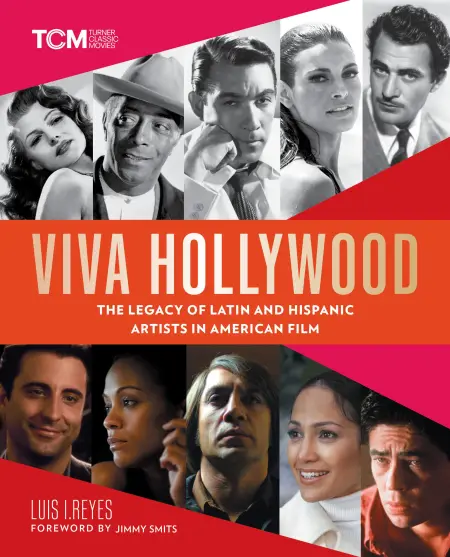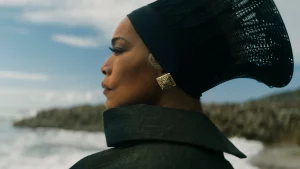Viva Hollywood
The Legacy of Latin and Hispanic Artists in American Film
by Luis I. Reyes
TCM and Running Press
Hardcover ISBN: 9780762478484
September 2022
Amazon — Barnes and Noble — Larry Edmund’s — Powell’s
“Latinx artists both in front of and behind the cameras are committed to creating entertaining, compelling stories, unforgettable characters, and indelible images of humanity that will bring a greater understanding of the society and the world we live in. They have a long history in the evolving art of motion pictures since its inception and are taking a more prominent place in the present and future of Hollywood and the world’s cinematic landscape.” — Luis I. Reyes
Hispanic and Latino artists have been part of the fabric of Hollywood from the very beginning. Because we are such a diverse mix of races and ethnicities, these actors and actresses have been cast to play a variety of roles that ranged from the exotic to the stereotypical and everything in between. Stars like Rita Hayworth had to change their name and appearance to become more mainstream. While others like Anthony Quinn had a look that was ethnically ambiguous enough that they were cast in everything except for their own ethnicity. Some represented certain ethnic types like the Latin lover, the spitfire/señorita or the bandito. Unfortunately, when there were big Latin roles to play, like Maria in West Side Story (1961), Hollywood preferred to cast white actors in brownface rather than their equally talented Latino counterparts. When Hollywood wasn’t ready to make room for Latino artists to be their authentic selves, they persisted, carving a path for themselves and for future talent to change perceptions and open up potential for better representation.
In his new book Viva Hollywood: The Legacy of Latin and Hispanic Artists in American Film, author Luis I. Reyes takes on the monumental task of sharing the stories of the many, many Hispanic and Latino artists, both in front of and behind the camera, who contributed to film history in their own unique ways. The majority of the book focuses on the classic film history but there is still plenty of information about artists working today.
The chapters are organized both chronologically and thematically. I was was most interested in the discussions on early matinee idols, how the Good Neighbor policy opened doors for Latino artists during WWII, problem/race pictures of the 1950s and 1960s, and the influx of Latino-focused movies during the 1980s and 1990s.
Each chapter includes individual biographies of key figures where relevant. Some of these individuals include: Gilbert Roland, Dolores Del Rio, Antonio Moreno, Ramon Novarro, Lupe Velez, Rita Hayworth. Carmen Miranda, Cesar Romero, Maria Montez, Olga San Juan, Ricardo Montalban, Anthony Quinn, Rita Moreno, Raquel Welch, etc.
 |
| Interior spread courtesy of Running Press via Edelweiss |
 |
| Interior spread courtesy of Running Press via Edelweiss |
Here are some interesting facts from the book:
- “When [Dolores Del Rio] was promoted in the press as Spanish or Castilian being white and European was considered superior to being Mexican, with its Indigenous pedigree, a discriminatory view that has not wholly disappeared today—she quickly insisted on being correctly described as Mexican.”
- “At the peak of her Hollywood career in 1945, Carmen Miranda was the highest-earning female performer in the United States.”
- “After the war, Romero and his good friend and fellow Fox star Tyrone Power took off on a two-month goodwill promotional tour of Latin America, sponsored by the studio and the US State Department. Power, who had served as a marine pilot during the war, flew a twin-engine Beech aircraft on the twenty-two-thousand- mile trip aided by a copilot. Romero, who spoke Spanish, acted as principal translator.”
- “[Xavier] Cugat decided to follow his musical calling, and inspired by the Afro- Cuban rhythms he was exposed to in his youth, he formed a Latin dance band with six musicians. This was a daring move in the 1920s, when Latin music was virtually unheard of in mainstream America except for the [Argentine] tango, which was labeled “gigolo music.”
- “In 1969, actors Ricardo Montalban, Val de Vargas, Rodolfo Hoyos Jr., Carlos Rivas, Henry Darrow, Gilbert Avila, Luis de Córdova, Robert Apodaca, and impresario Tony De Marco formed Nosotros (the Spanish word for “we, the people”), an actors’ advocacy organization dedicated to improving the image of Latino/Latina and Spanish-speaking peoples in Hollywood movies, television, theater, and radio.”
- “Stand and Deliver has become one of the most widely seen movies of any made in the United States through all media platforms, but also because it has been showcased in middle schools and high schools across the country as an inspirational and motivational teaching tool.”
As with many other TCM and Running Press books, Viva Hollywood is beautifully designed. I enjoyed the color palette (red, gold, orange, light purple and teal) as well as the recurring Art Deco style motifs.
With that said, I was mostly disappointed with the book, especially in how it presented its information. The themed chapters started with a few pages of history and context. These were interesting and I wish they were fleshed out essays. Instead they served like introductions to a series of Wikipedia style biographical portraits. There were so many of these that they became laborious to get through. I admire the author for cramming in as much information as he possibly could. There are so many artists covered from actors, actresses, directors, musicians, dancers, etc. You’ll be hard pressed to find someone who was left out. However, this came at the cost of an enjoyable reading experience.
I would recommend Viva Hollywood as a reference guide to dip in and out of rather than a book to read from cover to cover.



